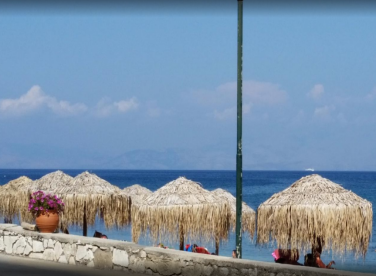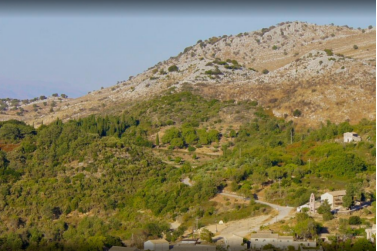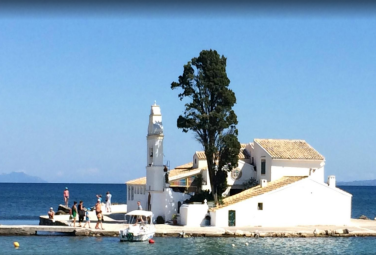Corfu, Corfu, Ionian Islands 作者: 来源: 发布时间:2021-05-17
I. Population, Area
Total Area: 610.9km2
Elevation: 906 m (2,972 ft)
Municipal unit density: 170/km2
Population: 102,071 (2011)

II.Geography (environment and resources)
Corfu is studded with whitewashed houses, Byzantine churches, and the remains of Venetian fortresses and Greek temples. Wander the ancient streets of the Roman village of Kassiopi or explore the central Esplanade of the eponymous Corfu Town. For a DIY spa experience, lather yourself in mineral mud on the shore of the Canal D’Amour. Legend has it that the waterfalls of Nymphes used to attract the mythological beauties of the same name, who would flock to the village to bathe in the pristine waters.
Corfu has ferry services both by traditional ferries to Gaios in the island of Paxoi and as far as Patras and both traditional ferries and advanced retractable airfoil, hydrodynamic-flow, high-speed ferries called "Flying Dolphins" to Igoumenitsa and Sarandë in neighbouring Albania. The small port of Lefkimmi is also to be found at the southernmost tip of the island on Cape Kavos, offering a ferry service to the mainland.
The Ioannis Kapodistrias International Airport, named after Ioannis Kapodistrias, a distinguished Corfiot and European diplomat, and the first governor of the independent Greek state, is located around three kilometres south of Kerkyra, just half a kilometre north of Pontikonisi. The approach and landing, in a northeasterly direction, afford passengers spectacular aerial views of Pontikonisi and Vlaheraina Monastery, also taking in the hills of Kanoni, as the runway employed for landing lies a few hundred metres from these spectacular local landmarks. The airport offers domestic flights from Olympic Airlines (OA 600, 602 and 606), and Aegean Airlines (A3 402, 404 and 406). Seaplanes, Air Sea Lines, a Greek seaplane operator, offers scheduled flights from Corfu to Paxoi, Lefkada, Ithaki, Kefalonia, Ioannina, Patras and Brindisi in Italy.
The buses to the main places on the island run about six times a day between the city and Glyfada, Sidari, Paleokastritsa, Roda and Acharavi, Lefkimmi, Lefkimmi and Piri. Other coaches drive up to twice a day to Athens and Thessaloniki. City buses run through the city to the Airport, Achilleion, Gouvia, Afra, Pelekas and some other places of interest.
The Diapontia Islands are accessible by boat with regular services from Corfu port and Agios Stefanos Avliotes and by ferrie from Corfu city port.
The island is linked by two motorways, GR-24 in the northwest and GR-25 in the south.
Greek National Road 24, Cen., NW, Corfu – Palaiokastritsa
Greek National Road 25, Cen., S, SE, Corfu – Lefkimi

III. ECONOMY
lCorfu is mostly planted with olive groves and vineyards and has been producing olive oil and wine since antiquity.
lThe main wine grape varietals found in Corfu are the indigenous white Kakotrýgēs and red Petrokóritho, the Cefalonian white Robóla, the Aegean Moscháto (white muscat), the Achaean Mavrodáphnē and others.
lModern times have seen the introduction of specialist cultivation supported by the mild climate, like the kumquat and bergamot oranges, which are extensively used in making spoon sweets and liqueurs.
lCorfu also produces local animal products, such as Corfiote graviéra (a variant of gruyere) and "Corfu" cheese (a variant of Grana); "Corfu butter" (Boútyro Kerkýras), an intensely flavored cooking and baking butter made of ewe's milk; and the noúmboulo salami made of pork and lard and flavored with orange peel, oregano, thyme and other aromatic herbs, which are also burned for smoking. Local culinary specialties include sofrito (a veal rump roast of Venetian origin), pastitsáda (bucatini pasta served with diced veal cooked in a tomato sauce), bourdétto (cod cooked in a peppery sauce), mándoles (caramelized almonds), pastéli (honey bars made with sesame, almonds or pistacchios), mandoláto (a "pastéli" made of crushed almonds, sugar, honey and vanilla), and tzitzibíra, the local ginger beer, a remnant of the British era.
lThere are three beweries in Corfu and one bed layers factory. The island has again become an important port of call and has a considerable trade in olive oil. In earlier times there was a great export of citron, which was cultivated here, including for ritual use in the Jewish community during the Sukkot holiday.

IV. History
The earliest reference to Corfu is the Mycenaean Greek word ko-ro-ku-ra-i-jo ("man from Kerkyra") written in Linear B syllabic script, c. 1300 BC. According to Strabo, Corcyra (Κόρκυρα) was the Homeric island of Scheria (Σχερία), and its earliest inhabitants were the Phaeacians (Φαίακες). The island has indeed been identified by some scholars with Scheria, the island of the Phaeacians described in Homer's Odyssey, though conclusive and irrefutable evidence for this theory or for Ithaca's location have not been found. Apollonius of Rhodes depicts the island in Argonautica as a place visited by the Argonauts. Jason and Medea were married there in 'Medea's Cave'. Apollonius named the island Drepane, Greek for "sickle", since it was thought to hide the sickle that Cronus used to castrate his father Uranus, from whose blood the Phaeacians were descended. In an alternative account, Apollonius identifies the buried sickle as a scythe belonging to Demeter, yet the name Drepane probably originated in the sickle-shape of the island. According to a scholiast, commenting on the passage in Argonautica, the island was first of all called Macris after the nurse of Dionysus who fled there from Euboea.
Others have asserted that Corfu was Taphos, the island of the lelegian Taphians.
According to Strabo (VI, 269), the Liburnians were masters of the island Korkyra (Corfu), until 735 BC, when they left it, under pressure of Corinthian ruler Hersikrates, in a period of Corinthian expansion to South Italy, Sicily and Ionian Sea.
At a date no doubt previous to the foundation of Syracuse, Corfu was peopled by settlers from Corinth, probably 730 BC, but it appears to have previously received a stream of emigrants from Eretria. The commercially advantageous location of Corcyra on the way between Greece and Magna Grecia, and its fertile lowlands in the southern section of the island favoured its growth and, influenced perhaps by the presence of non-Corinthian settlers, its people, quite contrary to the usual practice of Corinthian colonies, maintained an independent and even hostile attitude towards the mother city.
This opposition came to a head in the early part of the 7th century BC, when their fleets fought the first naval battle recorded in Greek history: 665 BC according to Thucydides. These hostilities ended in the conquest of Corcyra by the Corinthian tyrant Periander (Περίανδρος) who induced his new subjects to join in the colonization of Apollonia and Anactorium. The island soon regained its independence and thenceforth devoted itself to a purely mercantile policy. During the Persian invasion of 480 BC it manned the second largest Greek fleet (60 ships), but took no active part in the war. In 435 BC it was again involved in a quarrel with Corinth over the control of Epidamnus, and sought assistance from Athens (see Battle of Sybota).
This new alliance was one of the chief immediate causes of the Peloponnesian War, in which Corcyra was of considerable use to the Athenians as a naval station, but did not render much assistance with its fleet. The island was nearly lost to Athens by two attempts of the oligarchic faction to effect a revolution; on each occasion the popular party ultimately won the day and took a most bloody revenge on its opponents (427 BC and 425 BC).
During the Sicilian campaigns of Athens Corcyra served as a supply base; after a third abortive rising of the oligarchs in 410 BC it practically withdrew from the war. In 375 BC it again joined the Athenian alliance; two years later it was besieged by a Spartan force, but in spite of the devastation of its flourishing countryside held out successfully until relieved. In the Hellenistic period Corcyra was exposed to attack from several sides.
In 303 BC, after a vain siege by Cassander, the island was occupied for a short time by the Lacedaemonian general Cleonymus of Sparta, then regained its independence and later it was attacked and conquered by Agathocles of Syracuse. He offered Corfu as dowry to his daughter Lanassa on her marriage to Pyrrhus, King of Epirus. The island then became a member of the Epirotic alliance. It was then perhaps that the settlement of Cassiope was founded to serve as a base for the King of Epirus' expeditions. The island remained in the Epirotic alliance until 255 BC when it became independent after the death of Alexander, last King of Epirus. In 229 BC, following the naval battle of Paxos, it was captured by the Illyrians, but was speedily delivered by a Roman fleet and remained a Roman naval station until at least 189 BC. At this time, it was governed by a prefect (presumably nominated by the consuls), but in 148 BC it was attached to the province of Macedonia. In 31 BC, it served Octavian (Augustus) as a base against Mark Antony.
Roman and medieval history
Pontikonisi island is home of the monastery of Pantokrator (Μοναστήρι του Παντοκράτορος). The Greek word Ποντικονήσι (pontikonissi) means “mouse island”; the white staircase of the monastery resembles from afar a mouse tail.
Christianity arrived in Corfu early; two disciples of Saint Paul, Jason of Tarsus and Sosipatrus of Patras, taught the Gospel, and according to tradition the city of Corfu and much of the island converted to Christianity. Their relics were housed in the old cathedral (at the site of the current Old Fortress, before a dedicated church was built for them c. 100 AD.
During Late Antiquity (late Roman/early Byzantine period), the island formed part of the province of Epirus Vetus in the praetorian prefecture of Illyricum. In 551, during the Gothic War, the Ostrogoths raided the island and destroyed the city of Corfu, then known as Chersoupolis (Χερσούπολις, "city on the promontory") because of its location between Garitsa Bay and Kanoni. Over the next centuries, the main settlement was moved north, to the location of the current Old Fortress, where the rocky hills offered natural protection against raids. From the twin peaks of the new site, the medieval city received its new name, Korypho (Κορυφώ, "city on the peak") or Korphoi (Κορφοί, "peaks"), whence the modern Western name of "Corfu". The previous site of the city, now known as Palaiopolis (Παλαιόπολις, "old city"), continued to be inhabited for several centuries, however.
From at least the early 9th century, Corfu and the other Ionian Islands formed part of the theme of Cephallenia. This naval theme provided a defensive bulwark for Byzantium against western threats, but also played a major role in securing the sealanes to the Byzantine possessions in southern Italy. Indeed, traveller reports from throughout the middle Byzantine period (8th–12th centuries) make clear that Corfu was "an important staging post for travels between East and West". Indeed, the medieval name of Corfu first appears (Latinized Coryphus) in Liutprand of Cremona's account of his 968 embassy to the Byzantine court. Corfu enjoyed relative peace and safety during the Macedonian dynasty (867–1054), which allowed the construction of a monumental church to Saints Iason and Sosipatrus outside the city wall of Palaiopolis. Nevertheless, in 933, the city, led by its archbishop, Arsenios, withstood a Saracen attack; Arsenios was canonized and became the city's patron saint.
The peace and prosperity of the Macedonian era ended with another Saracen attack in 1033, but more importantly with the emergence of a new threat: following the Norman conquest of Southern Italy, the ambitious Norman monarchs set their sights on expansion in the East. Three times on the space of a century Corfu was the first target and served as a staging area for the Norman invasions of Byzantium. The first Norman occupation from 1081 to 1084 was ended only after the Byzantine emperor Alexios I Komnenos secured the aid of the Republic of Venice, in exchange to wide-ranging commercial concessions to Venetian merchants. The admiral George of Antioch captured Corfu again in 1147, and it took a ten-month siege for Manuel I Komnenos to recover the island in 1149. In the third invasion in 1185, the island was again captured by William II of Sicily, but was soon regained by Isaac II Angelos.
During the break-up of the Byzantine Empire the island was occupied by Genoese privateers (1197–1207), who in turn were expelled by the Venetians. In 1214 it passed to the Greek despots of Epirus, who gave it to Manfred of Sicily as a dowry in 1259. At his death in 1267 it passed with his other possessions to the house of Anjou. Under the latter, the island suffered considerably from the inroads of various adventurers.
The island was one of the first places in Europe in which Romani people ("Gypsies") settled. In about 1360, a fiefdom, called the Feudum Acinganorum was established, with mainly Romani serfs. From 1386, Corfu was controlled by the Republic of Venice, which in 1401 acquired formal sovereignty and retained it until the French Occupation of 1797. Corfu became central for the propagation of the activities of the Filiki Etaireia among the Greek Diaspora and philhellenic societies across Europe, through nobles like Ioannis Kapodistrias and Dionysios Romas.
V.Contact Information
Mayor:Merope Hydraiou
Website: www.corfu.gr
